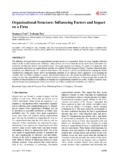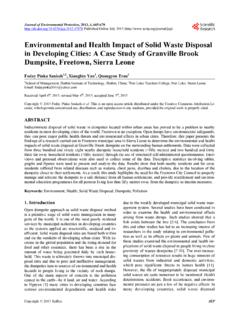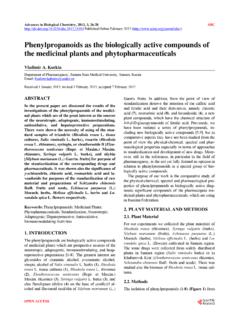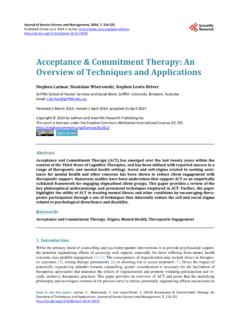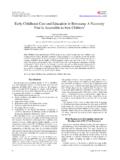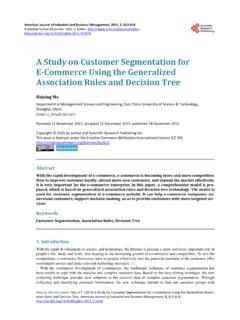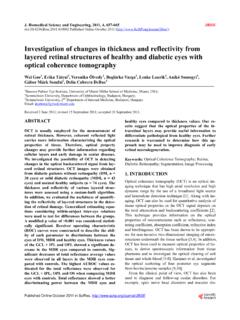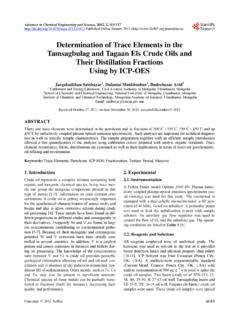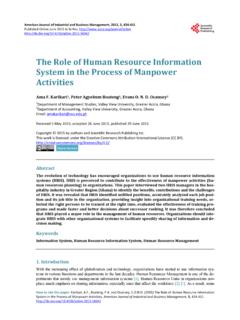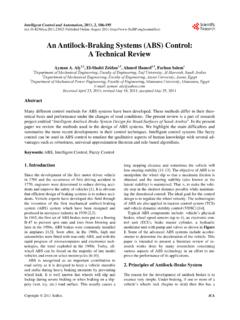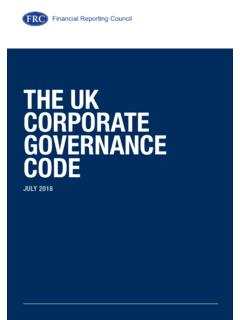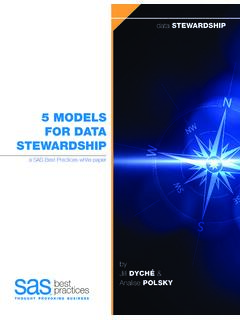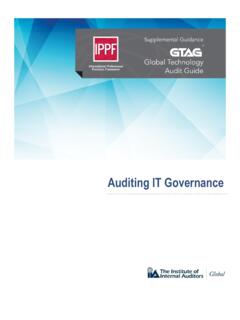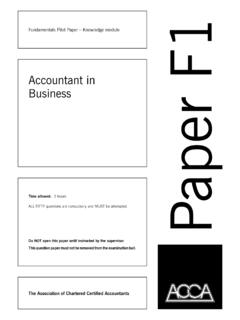Transcription of Corporate Accounting Fraud: A Case Study of Satyam ...
1 Open Journal of Accounting , 2013, 2, 26-38 Published Online April 2013 ( ) Corporate Accounting Fraud: A Case Study of Satyam Computers Limited Madan Lal Bhasin Bang College of Business, KIMEP University, Almaty, Republic of Kazakhstan Email: Received January 15, 2013; revised March 12, 2013; accepted March 28, 2013 Copyright 2013 Madan Lal Bhasin. This is an open access article distributed under the Creative Commons Attribution License, which permits unrestricted use, distribution, and reproduction in any medium, provided the original work is properly cited. ABSTRACT From Enron, WorldCom and Satyam , it appears that Corporate Accounting fraud is a major problem that is increasing both in its frequency and severity. Research evidence has shown that growing number of frauds have undermined the integrity of financial reports, contributed to substantial economic losses, and eroded investors confidence regarding the usefulness and reliability of financial statements.
2 The increasing rate of white-collar crimes demands stiff penalties, exemplary punishments, and effective enforcement of law with the right spirit. An attempt is made to examine and ana- lyze in-depth the Satyam Computer s creative- Accounting scandal, which brought to limelight the importance of ethics and Corporate governance (CG). The fraud committed by the founders of Satyam in 2009, is a testament to the fact that the science of conduct is swayed in large by human greed, ambition, and hunger for power, money, fame and glory . Unlike Enron, which sank due to agency problem, Satyam was brought to its knee due to tunneling effect. The Satyam scandal highlights the importance of securities laws and CG in emerging markets. Indeed, Satyam fraud spurred the government of India to tighten the CG norms to prevent recurrence of similar frauds in future.
3 Thus, ma- jor financial reporting frauds need to be studied for lessons-learned and strategies-to-follow to reduce the incidents of such frauds in the future. Keywords: Corporate Accounting Frauds; Satyam Computers; Case Study ; India; Corporate governance ; Accounting and Auditing Standards 1. Introduction What Is Fraud? Fraud is a worldwide phenomenon that affects all conti- nents and all sectors of the economy. Fraud encompasses a wide-range of illicit practices and illegal acts involving intentional deception, or misrepresentation. According to the Association of Certified Fraud Examiners (ACFE), fraud is a deception or misrepresentation that an indi- vidual or entity makes knowing that misrepresentation could result in some unauthorized benefit to the individ- ual or to the entity or some other party [1].
4 In other words, mistakes are not fraud. Indeed, in fraud, groups of unscrupulous individuals manipulate, or influence the activities of a target business with the intention of mak- ing money, or obtaining goods through illegal or unfair means. Fraud cheats the target organization of its legiti- mate income and results in a loss of goods, money, and even goodwill and reputation. Fraud often employs ille- gal and immoral, or unfair means. It is essential that or- ganizations build processes, procedures and controls that do not needlessly put employees in a position to commit fraud and that effectively detect fraudulent activity if it occurs. The fraud involving persons from the leadership level is known under the name managerial fraud and the one involving only entity s employees is named fraud by employees association.
5 Magnitude of Fraud Losses: A Glimpse Organizations of all types and sizes are subject to fraud. On a number of occasions over the past few decades, major public companies have experienced financial re- porting fraud, resulting in turmoil in the capital markets, a loss of shareholder value, and, in some cases, the bankruptcy of the company itself. Although, it is gener- ally accepted that the Sarbanes-Oxley Act has improved Corporate governance and decreased the incidence of fraud, recent studies and surveys indicate that investors and management continue to have concerns about finan- cial statement fraud. For example: Copyright 2013 SciRes. OJAcct M.
6 L. BHASIN 27 The ACFE s 2010 Report to the Nations on Occupa- tional Fraud and Abuse [1] found that financial statement fraud, while representing less than five percent of the cases of fraud in its report, was by far the most costly, with a median loss of $ million per incident. Survey participants estimated that the typical organization loses 5% of its revenues to fraud each year. Applied to the 2011 Gross World Product, this figure translates to a potential projected annual fraud loss of more than $ trillion. The median loss caused by the occupational fraud cases in our Study was $140,000. More than one-fifth of these cases caused losses of at least $1 million. The frauds re- ported to us lasted a median of 18 months before be- ing detected.
7 Fraudulent Financial Reporting: 1998-2007 , from the Committee of Sponsoring Organizations of the Treadway Commission (the 2010 COSO Fraud Re- port) [2], analyzed 347 frauds investigated by the US Securities and Exchange Commission (SEC) from 1998 to 2007 and found that the median dollar amount of each instance of fraud had increased three times from the level in a similar 1999 Study , from a median of $ million in the 1999 Study to $12 mil- lion. In addition, the median size of the company in- volved in fraudulent financial reporting increased ap- proximately six-fold, from $16 million to $93 million in total assets and from $13 million to $72 million in revenues. A 2009 KPMG Survey [3] of 204 executives of US companies with annual revenues of $250 million or more found that 65 percent of the respondents con- sidered fraud to be a significant risk to their organiza- tions in the next year, and more than one-third of those identified financial reporting fraud as one of the highest risks.
8 Fifty-six percent of the approximately 2100 business professionals surveyed during a Deloitte Forensic Center [4] webcast about reducing fraud risk pre- dicted that more financial statement fraud would be uncovered in 2010 and 2011 as compared to the pre- vious three years. Almost half of those surveyed (46 percent) pointed to the recession as the reason for this increase. According to Annual Fraud Indicator 2012 con- ducted by the National Fraud Authority (UK) [5], The scale of fraud losses in 2012, against all victims in the UK, is in the region of 73 billion per annum. In 2006, 2010 and 2011, it was 13, 30 and 38 billions, respectively. The 2012 estimate is significantly greater than the previous figures because it includes new and improved estimates in a number of areas, in particular against the private sector.
9 Fraud harms all areas of the UK economy . Moreover, financial statement fraud was a contributing factor to the recent financial crisis and it threatened the efficiency, liquidity and safety of both debt and capital markets [6]. Furthermore, it has significantly increased uncertainty and volatility in financial markets, shaking investor confidence worldwide. It also reduces the cred- itability of financial information that investors use in investment decisions. When taking into account the loss of investor confidence, as well as, reputational damage and potential fines and criminal actions, it is clear why financial misstatements should be every manager s worst fraud-related nightmare [7]. Who Commits Frauds? Everyday, there are revelations of organizations behaving in discreditable ways [8].
10 Generally, there are three groups of business people who commit financial state- ment frauds. They range from senior management (CEO and CFO); mid- and lower-level management and organ- izational criminals [9]. CEOs and CFOs commit ac- counting frauds to conceal true business performance, to preserve personal status and control and to maintain per- sonal income and wealth. Mid- and lower-level employ- yees falsify financial statements related to their area of responsibility (subsidiary, division or other unit) to con- ceal poor performance and/or to earn performance-based bonuses. Organizational criminals falsify financial sta- tements to obtain loans, or to inflate a stock they plan to sell in a pump-and-dump scheme. While many chan- ges in financial audit processes have stemmed from fi- nancial fraud, or manipulations, history and related re- search repeatedly demonstrates that a financial audit simply cannot be relied upon to detect fraud at any sig- nificant level.
